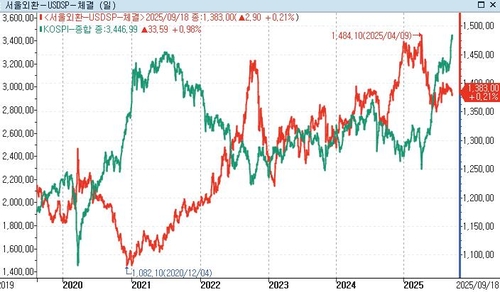(Seoul=Yonhap Infomax) The dollar-won exchange rate remains stubbornly high, defying both domestic and global market variables. This has prompted many market participants to question the underlying causes, as the won continues to show weakness even amid expectations of a U.S. Federal Reserve rate cut and robust inflows of foreign capital into South Korea’s equity markets.
South Korea’s benchmark KOSPI index has been on a relentless upward trajectory. On the 1st, the KOSPI hit a short-term low of 3,135, then quickly surpassed the 3,200, 3,300, and even the 3,400 mark, setting new records in the nation’s capital markets. During this period, foreign investors recorded net purchases approaching 7 trillion won ($5.9 billion).
Despite the KOSPI’s surge, the dollar-won exchange rate has hovered above 1,380 won, showing little sign of retreat. The positive effects of foreign equity inflows and the KOSPI rally are not being fully reflected in the currency market. Traditionally, a rise in the KOSPI driven by foreign capital would lead to a stronger won and a lower dollar-won rate, while a falling KOSPI would push the exchange rate higher. The current divergence marks a clear departure from this historical pattern: while domestic stock prices climb, the won, a key representative of Korean assets, remains persistently weak.

South Korea’s fiscal soundness is not deteriorating to a degree that would justify the won’s weakness. In fact, the nation’s credit default swap (CDS) premium—a key indicator of sovereign default risk—remains lower than those of major advanced economies. According to Yonhap Infomax data, as of the 17th, South Korea’s five-year CDS premium stood at 18.14 basis points, below Japan’s 18.76bp, the UK’s 19.16bp, France’s 34.47bp, and the U.S.’s 40.20bp.
This has led analysts to seek alternative explanations for the won’s underperformance. One prominent factor is South Korea’s large-scale investment commitments to the United States as part of ongoing tariff negotiations. Since the inauguration of President Donald Trump, the won has underperformed other major currencies.
From January 20, when President Trump took office, through the previous day, the won appreciated 4.63% against the U.S. dollar, reflecting easing concerns over tariff talks and expectations of U.S. rate cuts. However, this appreciation lags behind other currencies: the euro gained 13.41% against the dollar, the Japanese yen rose 5.90%, and even the Taiwan dollar and Thai baht appreciated by 7–8% over the same period.
In the foreign exchange market, the $350 billion in U.S.-bound investments agreed during tariff negotiations is seen as the main obstacle to a lower dollar-won rate. This amount exceeds 80% of South Korea’s foreign reserves, which stood at $416.3 billion at the end of August. Although specific investment plans have yet to be finalized, the process of executing such large-scale U.S. investments is fueling demand for dollars and uncertainty, thereby pressuring the won. The Bank of Korea has also noted that tariffs and U.S.-bound investments are likely to reduce net exports, and that dividend income from these investments will not fully offset the impact, contributing to further won weakness. The government’s proposal of a currency swap with the U.S. during tariff negotiations—despite the absence of a global financial crisis—appears closely related to these concerns.
Ultimately, U.S. tariff pressure is no longer limited to trade issues but is exerting broad-based strain on the Korean economy through exchange rates, domestic demand, inflation, and monetary policy.
(Editor-in-Chief)
eco@yna.co.kr
(End)
Copyright © Yonhap Infomax Unauthorized reproduction and redistribution prohibited.

